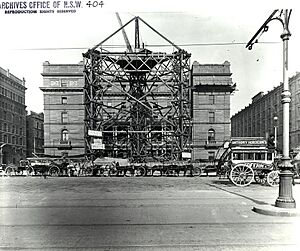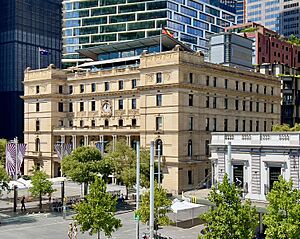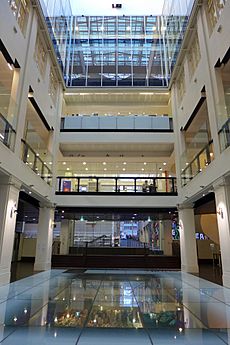Customs House, Sydney facts for kids
Quick facts for kids Customs House, Sydney |
|
|---|---|
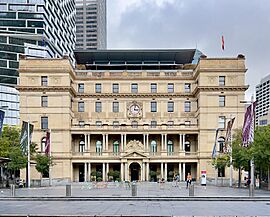
The front of the Customs House building.
|
|
| General information | |
| Status | Complete |
| Type | Government administration:
|
| Architectural style | Victorian Georgian |
| Address | 45 Alfred Street, Circular Quay, Sydney CBD, New South Wales |
| Country | Australia |
| Coordinates | 33°51′44″S 151°12′39″E / 33.862195°S 151.210885°E |
| Construction started | 1844 |
| Completed | 1845, 1887 |
| Opened | 1845 |
| Owner | Council of the City of Sydney |
| Technical details | |
| Floor count | 6 |
| Design and construction | |
| Architect |
|
| Architecture firm | New South Wales Government Architect |
| Official name: Sydney Customs House (former) | |
| Criteria: | A.4, D.2, E.1, F.1 and H. |
| Designated: | 22 June 2004 |
| Reference #: | 105436 |
| Official name: Customs House (former); Site of former Customs House | |
| Type: | State heritage (built) |
| Criteria: | a., c., d., e., f. |
| Designated: | 2 April 1999 |
| Reference #: | 727 |
| Type: | Office building |
| Category: | Government and Administration |
The Customs House, Sydney is a famous historic building located at Circular Quay in Sydney, Australia. For a long time, it was a government building where workers managed goods coming into and out of the country. This is what a customs house does.
Today, the building is a popular spot for both locals and tourists. It is owned by the City of Sydney and is home to the City of Sydney Library, exhibition spaces, and cafes. It is a "heritage-listed" building, which means it is protected because of its importance to Australia's history.
One of its most popular features is a huge model of Sydney's city centre. It sits under a glass floor on the ground level, so you can walk over it and get a bird's-eye view of the city.
Contents
History of the Building
The site of the Customs House is very important in Australian history. It is near where the First Fleet from Britain landed in 1788, which was the beginning of the colony of New South Wales. It is said that the local Eora people watched the ships arrive from this very spot.
A local legend says the building is haunted by the ghost of a convict from 1790, who sometimes offers people rum!
Why Was It Built?
As Sydney grew into a busy port, it needed a proper building to handle all the trade. The man who pushed for the new building was Colonel John George Nathaniel Gibbes, the head of Customs.
Construction on the beautiful sandstone building began in 1844. It was designed by architect Mortimer Lewis. The project also provided jobs for stonemasons during a tough economic time in the colony. The building officially opened in 1845.
Growing with Sydney
As trade and immigration increased, the Customs House needed more space. The government workers there were in charge of collecting taxes on goods, checking people arriving in the country, and making sure no forbidden items came in.
The building was made much larger between 1883 and 1889. The original two-storey building was expanded to three floors, with new wings added on the sides. This work was managed by the famous architect James Barnet.
More changes came around the time of Federation in 1901. This was when Australia's colonies joined to become one nation. The Customs Service became a major department for the new Australian Government, and it needed even more room. More floors were added to the building to handle the extra work.
A New Life for an Old Building
For many years, the building stayed mostly the same. But as big ships started using other ports in Sydney, Circular Quay became less of a shipping hub. In 1990, the Customs Service moved to a new building.
In 1994, the Australian Government gave the building to the City of Sydney. It was carefully restored and opened to the public. After more work, it became a major tourist attraction for the 2000 Summer Olympics. In 2003, the City of Sydney Library moved in, making it a vibrant public space for everyone to enjoy.
Architecture and Design
The first version of the Customs House was a two-storey building in the Georgian style. It had thirteen large windows so that workers could look out and see the ships in Sydney Cove.
The building you see today is a mix of different time periods. The outside walls are made of very thick sandstone. Inside, the structure is supported by a combination of strong timber beams and a modern steel frame.
The building has six floors. The roof is covered with reddish-brown Marseilles tiles, which were made in Australia. Inside, you can find a mix of old and new. Some rooms have beautiful old plaster decorations, while others are modern. The large, open area in the center of the building, called an atrium, lets in lots of natural light.
The building is in excellent condition today thanks to careful restoration work.
Timeline of Changes
- 1845: The original two-storey building opens.
- 1885–1887: The building is expanded to three storeys with new side wings.
- 1896–1903: Two more floors are added, and a new wing is built at the back.
- 1915–1917: The central part of the building is rebuilt with a modern frame, and a sixth floor is added.
- 1996–1997: The building is restored and opened to the public as a cultural venue.
- 2003: The City of Sydney Library moves in.
Why Is This Building Protected?
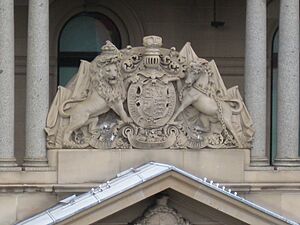
The Customs House is on the Commonwealth Heritage List and the New South Wales State Heritage Register. This means it is recognized as one of Australia's most important historic places.
Here are some of the reasons why it's so special:
- Historic Location: It stands on the site where European settlement in Australia began. It reminds us that Circular Quay was once the heart of the colony's sea trade.
- Record of History: The building itself is a record of Australia's growth. Its changes and additions show how the country and the Customs Service evolved over 145 years.
- Amazing Architecture: It showcases the work of three important government architects: Mortimer Lewis, James Barnet, and Walter Liberty Vernon. Even though they worked at different times, they created a building that looks unified and grand.
- Cultural Significance: The site is also important to Aboriginal people as the place where they first witnessed the arrival of Europeans.
See also
- Australian non-residential architectural styles



